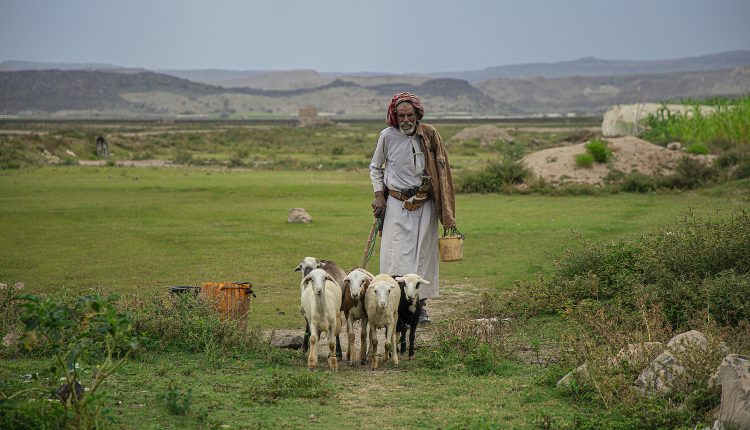Aden – The food security situation in Yemen’s districts under the control of the Government of Yemen (GoY) slightly improved during the first five months of this year, while acute malnutrition increased, compared to the same period in 2022. However, the outlook for the period between now until the end of 2023 indicates the need for more programme investments, as the modest improvements may be eroded, UN agencies have warned.
In a new Integrated Phase Classification (IPC) analysis on Yemen released today, the Food and Agriculture Organization of the United Nations (FAO), the United Nations Children’s Fund (UNICEF), and the UN World Food Programme (WFP) warned that, despite the slight improvements, nearly all districts under the control of the GoY were assessed to be facing high levels of food insecurity.
Yemen remains one of the most food insecure countries globally, mainly driven by the impact of conflict and economic decline, the three UN agencies added.
The report shows that Yemen continues to require attention, with hunger stalking millions of people and the situation could worsen if nothing is done to address the key drivers of food insecurity in the Middle Eastern country.
Despite modest improvements, second half of 2023 needs more investment
Today’s report showed that between January and May 2023, about 3.2 million people experienced high levels of acute food insecurity in the GoY areas, and these are classified in severe food insecurity (IPC Phase 3 and above), representing a 23 percent reduction from the October – December 2022 estimates.
Additionally, the number of people in Emergency (IPC Phase 4) almost halved to 781,000 compared to the estimates for the last quarter of 2022.
The three UN agencies warned that these modest improvements were only a ‘temporary reprieve’ as the key drivers of food insecurity remain and are projected to worsen during the period June to December 2023.
The IPC report projected a 20 percent increase in the number of people facing IPC Phase 3 and above (638,500 additional people) during the June to December period. The number of people likely to experience high levels of acute food insecurity (IPC Phase 3 or worse) is estimated to increase to 3.9 million (41 percent), out of which 2.8 million people are estimated to be in Crisis (IPC Phase 3) and 1.1 million in Emergency (IPC Phase 4).
The situation is likely to be compounded by a 20 percent decrease in humanitarian food assistance levels and the anticipated increase in food prices. While there has been a relative calm, sporadic fighting may continue in the frontline districts which further impacts food security.
Children and pregnant and lactating mothers facing acute malnutrition
As acute malnutrition continues to worsen in southern, it is estimated that in 2023, half a million children will be acutely malnourished, including nearly 100,000 children who are likely to be severely malnourished. It is also estimated that up to a quarter million pregnant and lactating women (PLW) will be acutely malnourished, while child stunting levels are also very high, ranging from 35.9 percent in Abyan Lowland to 64.3 percent in Hodeida Southern Lowland.
Critical situations of acute malnutrition (IPC AMN Phase 4) persist in some parts of the southern areas. The area-level classification is expected to deteriorate further during the projection period for acute malnutrition with all 16 zones of southern governorates being classified in IPC AMN phases 3 (Serious) and above, including seven zones in IPC AMN Phase 4 (Critical).
David Gressly, the UN Resident and Humanitarian Coordinator for Yemen, said: “The United Nations and its partners made strides in rolling back the worst food insecurity last year, but these gains remain fragile and 17 million people are still food insecure in Yemen. We thank generous donors for commitments made so far but need further support to reach the level of funding received last year to sustain an integrated humanitarian response. With adequate resources, we will reach millions of Yemenis with critical food and nutrition support, clean water, basic health care, protection and other necessities, while building people’s resilience and preparing communities across the country to withstand future shocks.”
“FAO is seized with this situation, and we are working directly with farmers on the ground to enable them to maintain their livelihoods. We make sure that smallholder farmers in Yemen will withstand any shocks which impact food security. As such, our focus, through various interventions, is to improve household food security and income by strengthening agricultural production practices, increasing labour opportunities, and diversifying livelihoods in a sustainable way that fosters peaceful coexistence,” said FAO Yemen Representative, Dr. Hussein Gadain.
UNICEF and partners reached about 420,000 children suffering from severe and acute malnutrition with lifesaving interventions in 2022., This is the highest ever reached in Yemen, thanks to the scale up of nutrition services in 4700 PHC facilities. Despite this, malnutrition levels remain critical in many areas of the Southern Governorates. A multi sectoral approach to address all forms of malnutrition is essential and together with partners UNICEF is strengthening the provision of primary health care, including early detection and treatment of severe acute malnutrition”, said UNICEF Yemen Representative, Peter Hawkins.
“WFP’s assistance is critical for getting people to firmer ground, for averting crisis and famine, for a better future, and we urge our donors to renew their commitment to supporting the most vulnerable Yemenis. Yemen’s food insecurity situation remains fragile, and the hard-won gains of the past 12 months will be lost without continued and urgent support from our donors. There are women, men and children behind these IPC statistics, whose lives straddle the fine line between hope and utter devastation. We simply cannot take our foot off the gas now,” said WFP Country Director, Richard Ragan.


Comments are closed.